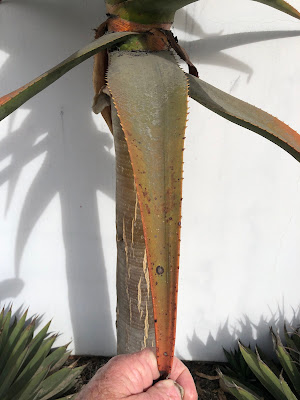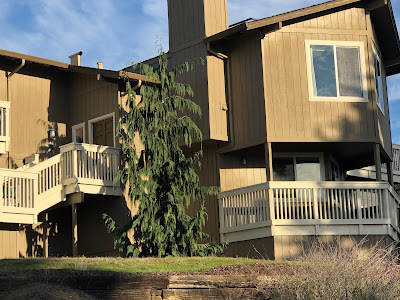Trees of Santa Cruz County
Santa Cruz County has a wide assortment of tree species grown and some great examples located in public spaces. Trees are covered like a field guide. Walking and Driving tree tours are listed on the right. Search by common name or tree attributes in the search engine.
Search This Blog
Wednesday, October 29, 2025
Hesperocyparis macrocarpa 'Saligna Aurea' - Golden Weeping Monterey Cypress
Monday, December 30, 2024
Quercus x ganderi - Gander's oak
I have been looking at these two Oaks for years and I think I am close to getting to the correct identification. I always guessed they were hybrids between the Coast Live Oak and California Black Oak but the difficulty was (is) the amount of hybridization and genetic studies that Q. agrifolia has been part of makes it difficult to come up with the name. Additionally, the experts are not in agreement.
My favorite old book "Pacific Coast Trees" by McMinn and Maino lists one hybrid, Q. morehus. More recent publications suggest there are more. But, perhaps the botanical variety oxyadenia is not really a distinct variety which eliminates the hybrid group.
Regardless of the name, I will continue.
Large semi-evergreen tree growing to 50' with a broadly oval outline. Often with multiple main branches. For those local, this one is on Bonita close to the Fire Department end.
This one has a different shape due to it growing up against a house.
Misidentification: Quercus kelloggii though those leaves are bigger, broader, more deeply lobed, and the acorn cap is different.
CalFlora calls this tree Q. Xchasei.
There was a species originally named Q. chasei (McMinn, 1949)
Kew Gardens considers the proper name as Q. Xganderi with Q. agrifolia var. oxyadenia and Q. kelloggii as the parents.
Cal Poly SLO does not mention Q. Xchasei
https://selectree.calpoly.edu/tree-detail/1727
Observers on Inaturalist refer to Q. XChasei as a synonym of Q. Xganderi though some use the prior as the proper name.
Location
Sunday, December 15, 2024
Aloe 'Hercules' - Hercules Tree Aloe
There are several tree aloes around and I am not sure which is which, but according to the owner of this row of trees, these are 'Hercules'. Hercules is a hybrid between A. barberae and A. dichotoma (San Marcos Nursery). They are faster growing than the parents with beautiful bark. They should grow to 25 feet or more depending on their location. My guess is on the shorter side since our climate is a bit cooler. They do grow pretty fast though. Very beautiful regardless of the name. (Also reclassified into a new genera, Aliodendron.)
Misidentification: Just about any other tree aloe unless you are well versed in these groups of plants, which I am not. Some people include Aloes such as A. speciosa, A. ferox and others like these but hard to compare them with Hercules.
Location:
Aptos - 290 Beach Pines Dr. along the RDM Blvd side of the house
Santa Cruz -
621 41st Ave. 2 double trunk plants.
321 Anchorage Ave. (Not 'Hercules' but "might be" Aloe barberae.)
181 24th St. (Not 'Hercules' but "might be" Aloe barberae.)
Tuesday, December 10, 2024
Acer x fremanii 'Jeffersred' - Autumn Blaze®
Friday, July 12, 2024
Pinus heldreichii - Bosnian Pine
I really like this smaller pine tree. I saw them years ago at the Morton Arboretum and a few in England. I am not sure who designed the Aptos Village green space but they picked a great tree on one side and a bit of a mistake on the other, oh well.
The Bosnian pine develops a tight upright conical shape with a height in Bosnia of maybe 50 feet tall. The older ones I have seen are no more than 25' tall. There are several cultivars in the trade but most are dwarf selections, though there is one that was really dark green and compact. But I'm not sure if it's one of those so I'll stick with the species. This image is the Aptos Village tree taken 6/24.
Bark is whitish gray. The older name for this species in Pinus leucodermis (white skin).
There is a cultivar named 'Compact Gem' which the plant in Aptos could be one though this cultivar is a bit rounded.
Misidentification: Austrian pine for sure, but the cones on the Austrian pine are not purple and are larger, the needles are longer as well.
Location:
Aptos: Aptos Village green space in a raised bed.
Santa Cruz: Arboretum
Callitropsis nootkatensis 'Pendula' - Weeping Alaskan Cedar
Great plant --- names are a mess --- one of my favorites of all time. This cultivar is distinctly weepy when compared to the species which is slightly weeping itself. Trees grow to about 30' tall by 15' wide in cultivation. The lateral branches are slightly upright or horizontal with drooping branchlets giving the tree a graceful soft look.
This tree was sitting in a large nursery box for several or more years prior to being planted. Could have been placed a bit further from the house, they make such great focal points in landscapes.
Leaves are arranged on flat sprays (branchlets).
Leaves opposite one-another, sort of in 4 rows, scale-like, bluish green in color, no more than 1/8" with distinct white lines on the lower surface where the leaves overlap.
Cones are smaller than Monterey cypress but larger than the Lawson falsecypress. They have a sharp bract (point) on the end of each scale. Usually 4 scales. Maturing brown and opening on the tree.
Bark is thin, gray silver in color with small resin bumps.
This is the "non" weeping species showing the more upright lateral branching with drooping branchlets.
These are 'Strict Weeping' at The Oregon Garden in Silverton.
These are also 'Strict Weeping' in Chelan WA.
I mentioned at the top of this post that the plant was great, but the naming is a mess. I prefer Chamaecypress nootkatensis, but that's because it's what I call it.
Kew Garden places the plant in Callitropsis and Wikipedia lists all of the names this poor plant has been given in alphabetic order but not chronological order. Read the wiki page for an interesting history lesson in plant classification and nomenclature.
Sunday, October 8, 2017
Neolitsea sericea
This evergreen tree has a rounded, dense habit, reportedly growing up to 35'. This one seems to be close to 25' and about the same width.
Foliage is evergreen, simple, elliptical, oblong to ovate, about 3 -7" long, with three distinct veins coming from the base. Medium to dark green.
Stems should have the same reddish colored hairs eventually turning green.
Flower buds are copper colored in clusters at the tips of the branches.
Misidentification:
not sure, look at the leaves for the silvery lower surface and the 3 veins, and of course the red newish foliage.
Location:
Santa Cruz
100 Myrtle St.





















































